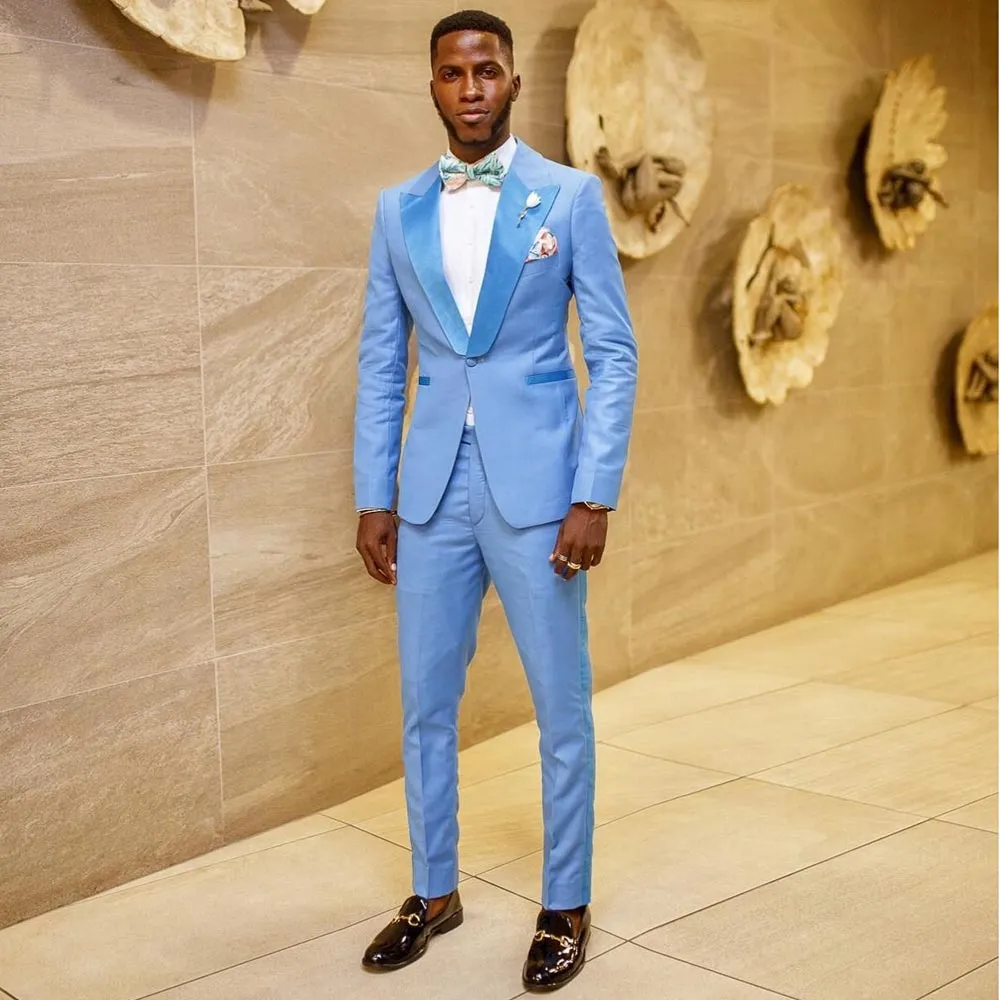Choosing the right wedding suit is crucial for any groom. It sets the tone for the day and reflects personal style while complementing the overall theme of the wedding. A well-selected suit features quality fabrics and colors that not only look great but also enhance the groom’s presence on one of the most significant days of his life. In this article, we will explore the essential fabrics and colors for wedding suits, providing guidance for a timeless and elegant look.
Understanding the Importance of Fabric
The Role of Fabric in a Wedding Suit
The fabric of a wedding suit plays an essential role in its overall appearance, comfort, and functionality. It affects the suit’s drape, breathability, and structure, each contributing to how the suit looks and feels when worn. Materials also impact how appropriate the suit is for different seasons and locations.
For instance, lighter fabrics are more suitable for summer weddings, while heavier materials provide warmth for winter ceremonies. Understanding fabric characteristics will help you make an informed choice that balances style and comfort.
Common Fabrics for Wedding Suits
Wool is one of the most common fabrics used for wedding suits. It is versatile and suitable for various occasions. Wool is breathable, perfect for warm weather, yet it also holds heat, making it suitable for cooler months. This natural fiber has a beautiful drape that enhances the suit’s structure while providing a polished look.
Another popular fabric is linen. Linen suits are developed from flax fibers and are extremely lightweight and comfortable. They provide excellent breathability, making them ideal for outdoor or summer weddings. However, linen wrinkles easily, so it may not be the best choice for formal events.
For more luxurious options, silk or silk blends offer an elegant sheen and soft feel. Silk suits are lightweight and breathable, making them perfect for summer weddings. They provide a refined and sophisticated appearance. Choosing the right fabric ensures that your wedding suit reflects not only your personal style but also the overall mood of the event.
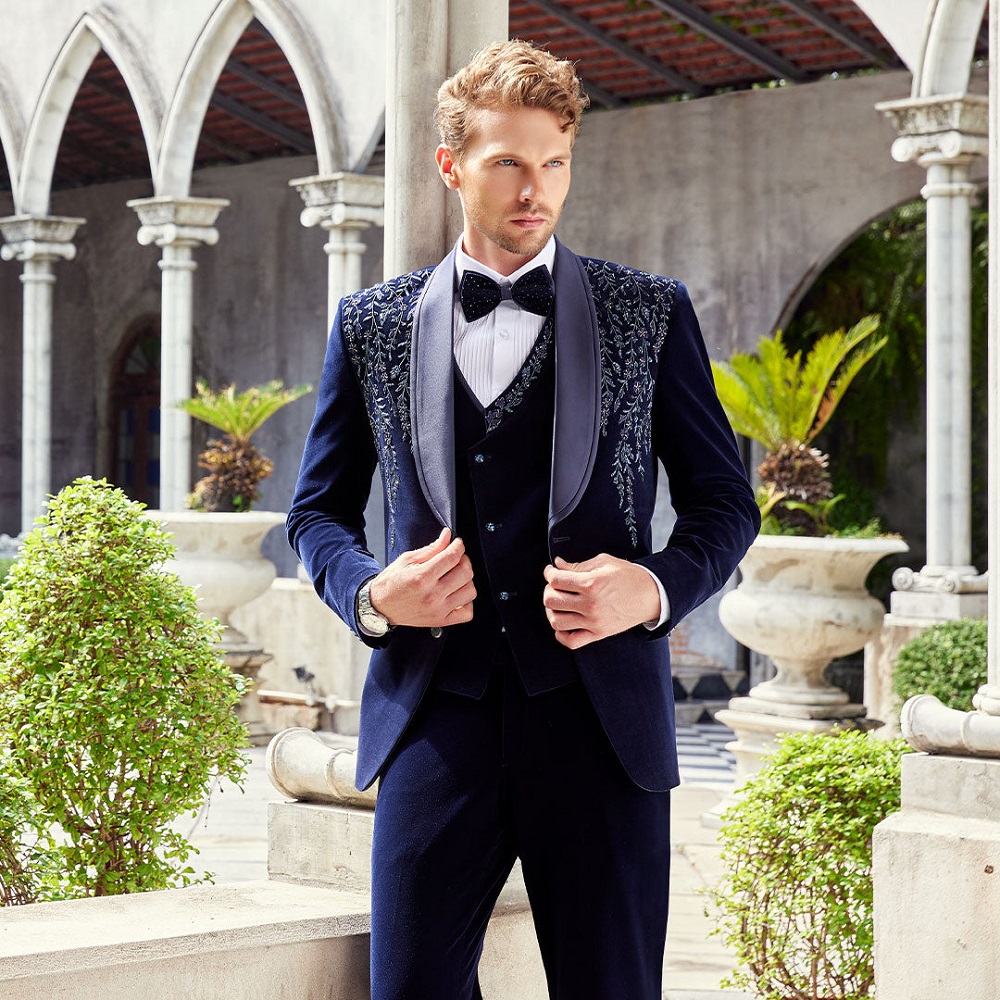
Color Choices for a Timeless Look
Classic Colors for Wedding Suits
When it comes to color, classic shades are always in style. Navy, black, and gray suits have long been favored for weddings, as they convey elegance and sophistication. A black suit is the traditional choice for formal weddings, providing a sleek and timeless aesthetic. A black suit pairs well with numerous tie options, ensuring versatility in overall style.
Navy suits have gained immense popularity for weddings in recent years. They offer a modern twist on the classic black suit while still retaining formality. Navy suits work well in various wedding settings, be it formal or semi-formal. They also complement a wide range of color palettes found in wedding themes.
Another classic option is the gray suit. Light gray is perfect for daytime or spring weddings, while charcoal gray offers a deeper, more formal alternative. Gray suits can also be paired with different colors for accessories, allowing for numerous styling options. These classic colors can easily transcend trends, ensuring your wedding suit remains stylish for years to come.
Exploring Bold and Unique Colors
While classic colors are undoubtedly timeless, many grooms are opting for bold and unique colors for their wedding suits. Colors such as emerald green, burgundy, or deep purple offer a fresh alternative to traditional shades. These colors can make a statement, reflecting the couple’s personal style and the overall theme of the wedding.
When choosing a bold color, it is essential to consider how it coordinates with the bridal party’s attire and the wedding theme. Harmonizing your suit with the bridesmaid dresses or groomsmen attire creates a cohesive look that enhances the overall aesthetic of the wedding.
Another trend gaining popularity is the use of pastel shades. Soft colors like blush pink, light blue, or mint green provide a romantic and whimsical feel. These colors work beautifully for spring and summer weddings, creating a light and airy atmosphere. Pastel suits add charm and personality while still embodying a timeless look.

Suit Styles to Consider
Single vs. Double-Breasted Suits
When selecting a wedding suit, choosing between single-breasted and double-breasted styles is crucial. Single-breasted suits are characterized by a single row of buttons. They are most commonly worn and provide a sleek, modern look. This style is versatile, allowing you to dress it up or down depending on the accessories and shirt chosen.
In contrast, double-breasted suits feature overlapping front flaps and two rows of buttons. This style offers a classic appearance with more structure. A double-breasted suit can convey a sense of authority and elegance, making it an excellent choice for formal weddings. Whichever style you choose, ensure it resonates with your personal preferences and complements the wedding’s tone.
Tailored Fit
The fit of the suit is perhaps one of the most critical aspects when aiming for a timeless look. A well-tailored suit enhances your silhouette, giving a polished and sophisticated appearance. Tailoring allows for a custom fit that ensures comfort and freedom of movement—vital for a day filled with activities.
There are various fits to choose from, including slim fit, regular fit, and classic fit. Slim fit suits are tailored closely to the body, providing a modern and stylish look. Regular fit suits offer a balanced approach, providing comfort without being too loose. Classic fit suits are more traditional and provide ample space, allowing for maximum comfort. Choosing the right fit ensures the suit enhances your appearance while allowing for easy movement and comfort.
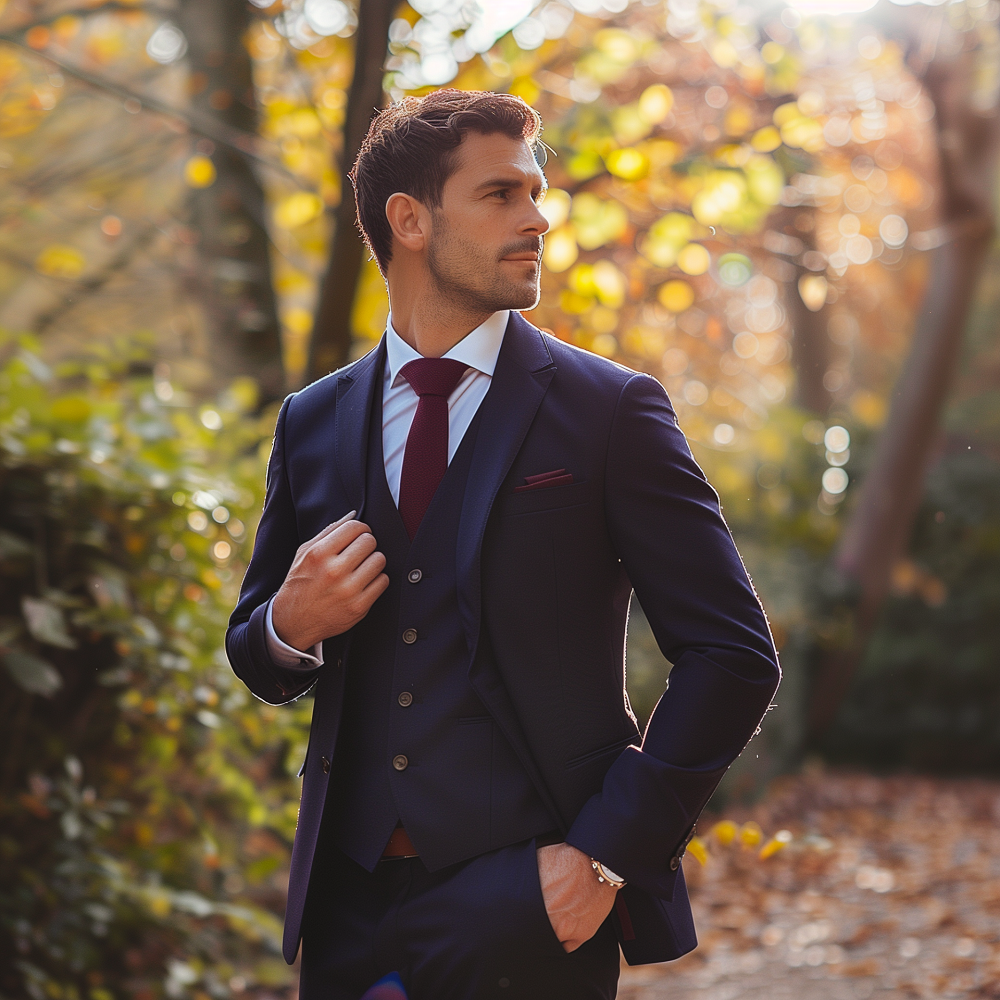
Accessorizing Your Wedding Suit
Ties and Bowties
Selecting the right tie or bowtie can elevate your wedding suit significantly. Ties come in various widths, materials, and patterns, allowing for a range of looks. A classic silk tie complements most suits and adds a touch of elegance. When choosing a tie, consider matching the color scheme of the wedding or incorporating the bride’s chosen colors.
Bowties have made a comeback in recent years, becoming a popular alternative for grooms. A bowtie adds personality and charm to your outfit. It is particularly suited for more formal weddings or when a whimsical touch is desired. Whether you choose a tie or a bowtie, ensure that it aligns with your overall aesthetic, enhancing the timeless quality of your wedding suit.
Pocket Squares, Cufflinks, and Boutonnieres
Accessories such as pocket squares, cufflinks, and boutonnieres also play a pivotal role in creating a polished look. A pocket square can add a pop of color or pattern, providing personality while still maintaining a classic appeal. Choose a pocket square that complements your tie or suit, harmonizing the entire ensemble.
Cufflinks are another essential accessory that can elevate your look. Gold or silver cufflinks create a refined appearance, while unique designs can express your individuality. Choose cufflinks that align with the overall theme of your wedding and add an extra touch of elegance.
Lastly, the boutonniere serves as a charming finishing touch for the groom’s look. Typically, the boutonniere features a flower or greenery that matches the wedding bouquet. It connects the groom’s outfit with the theme of the wedding and should be carefully chosen to enhance the overall aesthetic.
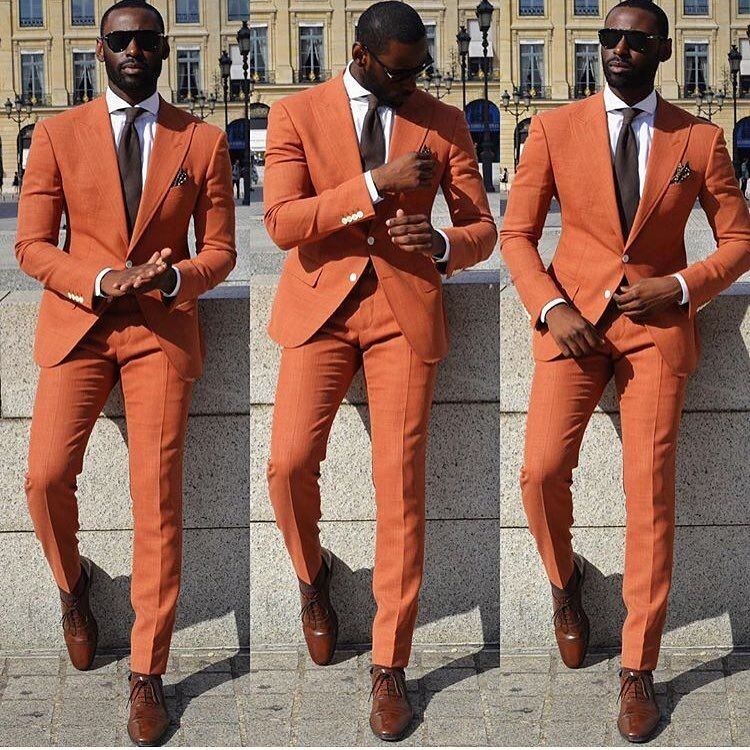
Seasonal Considerations for Wedding Suits
Choosing Fabrics for Different Seasons
When selecting a wedding suit, consider the season in which the wedding will take place. For summer weddings, lightweight fabrics like linen or breathable cotton blends are ideal. These materials keep you cool and comfortable during warmer months. Opt for light colors or pastel shades to reflect the refreshing vibe of summer.
In contrast, winter weddings demand heavier fabrics, such as wool or velvet. These materials provide warmth and a touch of luxury, perfect for formal winter ceremonies. Consider darker colors for winter weddings, as they tend to convey elegance and warmth. Choosing the appropriate fabric for the season ensures that you remain comfortable and stylish throughout your wedding day.
Layering for Transitional Seasons
For spring or fall weddings, layering becomes essential to adapt to varying temperatures. For these transitional seasons, consider adding a tailored vest beneath your jacket. These vests not only provide extra warmth but also add an element of sophistication to your ensemble.
You can also opt for a stylish overcoat, especially for outdoor ceremonies. A well-fitted overcoat can pull your entire look together while providing warmth and comfort. Layering effectively allows you to maintain your style, enhance the wedding theme, and ensure comfort throughout the day.
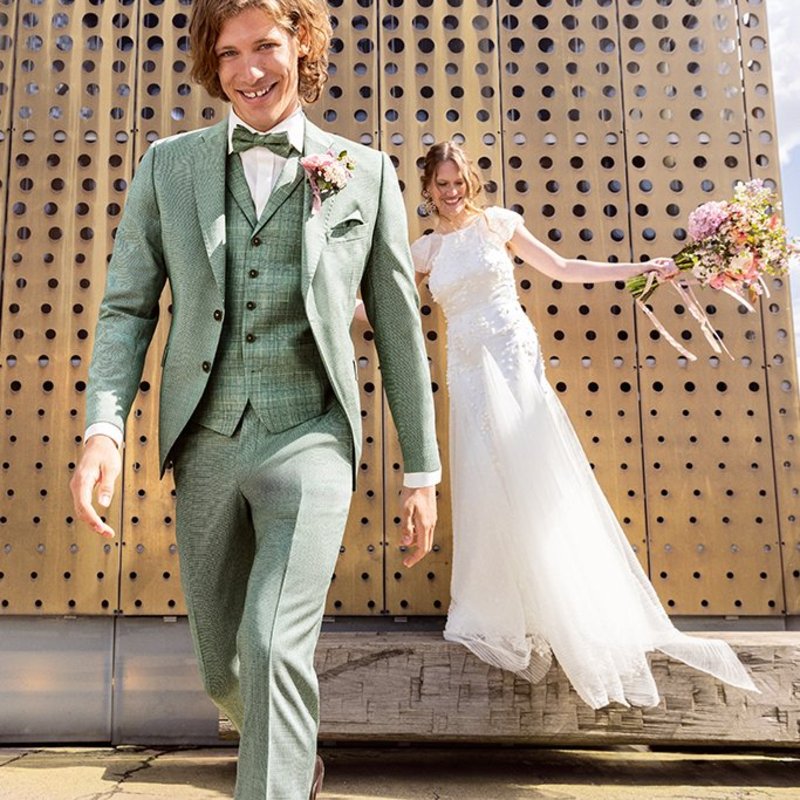
Custom Tailoring vs. Off-the-Rack Suits
The Benefits of Custom Tailoring
When selecting a wedding suit, you may face the decision of going for a custom-tailored suit or purchasing an off-the-rack option. Custom tailoring offers several benefits, mainly the perfect fit. A tailor can adjust every aspect of the suit to ensure it aligns with your body shape, providing ultimate comfort and style.
Customization also allows you to choose fabrics, colors, and styles that resonate with your vision for the wedding. This level of personalization ensures that your suit is entirely unique and meets your specifications. While custom suits may be more expensive, the investment pays off in comfort, style, and confidence on your wedding day.
Off-the-Rack Options
Alternatively, off-the-rack suits offer convenience and accessibility. Many brands produce off-the-rack options in various styles, colors, and sizes. This variety increases your chances of finding a suit that fits well and matches your preferences.
When choosing an off-the-rack suit, it is essential to try on several options. Sizing can vary between brands, and a good fit is crucial. If you find a suit you love but need minor adjustments, consider consulting a tailor for quick alterations. Combining off-the-rack suits with tailored adjustments allows you to achieve a stylish look without the extensive commitment of a full custom suit.
Caring for Your Wedding Suit
Proper Cleaning Techniques
Once your wedding day is complete, caring for your suit is essential to maintain its quality for future use. Many fabrics require specific cleaning and care. Always consult the care label for guidance on the appropriate cleaning method. Some suits may need dry cleaning, while others may be washable.
If you happen to get minor stains, treat them immediately. Blot, don’t rub, to prevent further spreading. Use mild detergent or fabric cleaner, and follow the care instructions. Taking care of your suit after the big day ensures it remains in good condition for future special occasions or events.
Proper Storage Solutions
When storing your wedding suit, it is essential to choose the proper storage method. Always keep the suit clean and dry before storage, as moisture can lead to mold growth and damage. It is best to store the suit in a breathable garment bag to protect it from dust and dirt.
If possible, hang the suit on a padded hanger that provides support for the shoulders. This helps retain its shape and prevents creasing. Avoid plastic covers, as they can trap moisture. With proper care and storage, your wedding suit will maintain its appearance and be ready for any future event.
In conclusion, choosing the right wedding suit requires careful consideration of fabrics, colors, and fit. By understanding these key elements, you can create a timeless look that reflects your personal style and enhances the wedding’s overall atmosphere.
Whether you opt for classic colors or bold statements, the right suit will make you feel confident on your special day. Additionally, proper care and storage will extend the life of your suit, allowing you to enjoy it for years to come. Embrace the journey of selecting the perfect wedding suit and enjoy the confidence it brings on your unforgettable day!
